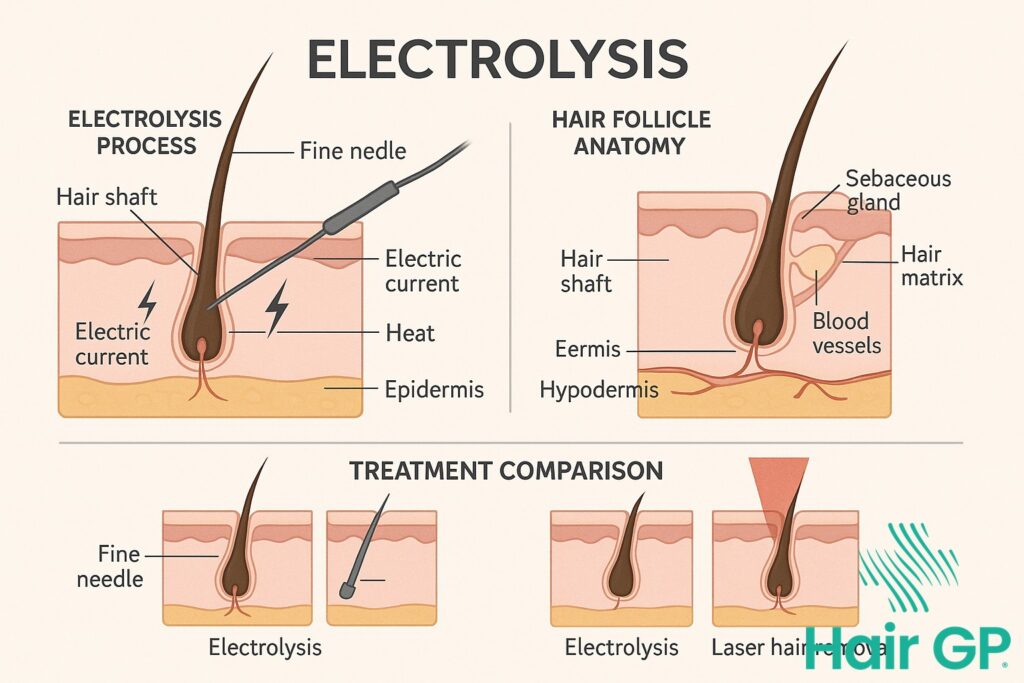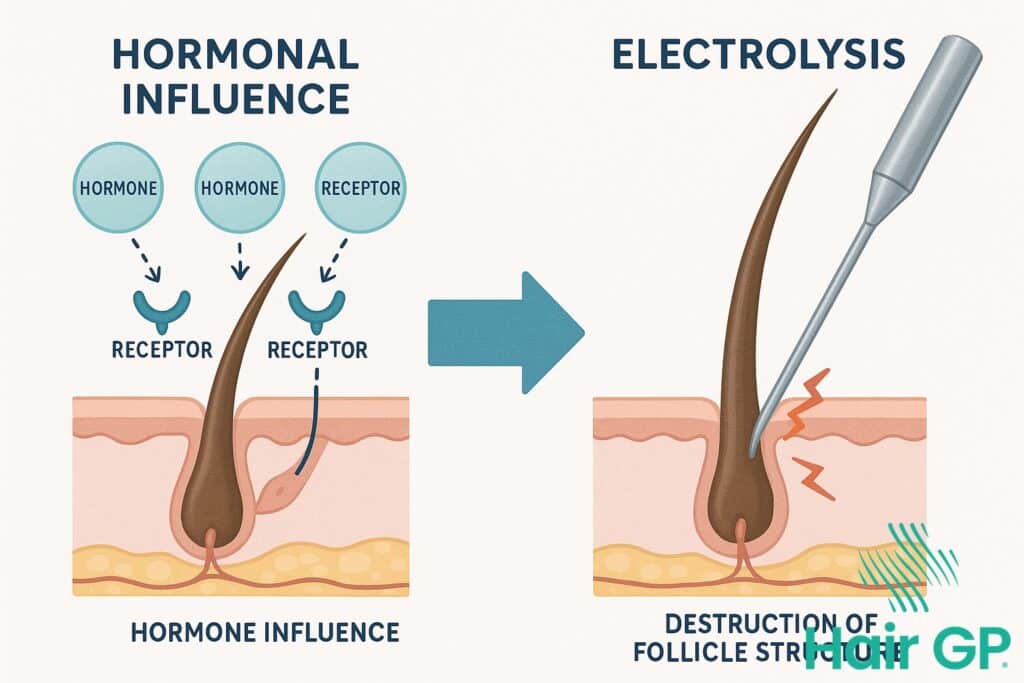Introduction
For millions of women living with hirsutism, the daily struggle with excessive hair growth in male-pattern areas can be emotionally overwhelming and physically exhausting. Whilst temporary methods offer fleeting relief, electrolysis stands alone as the only FDA-approved permanent hair removal solution that can definitively end the cycle of unwanted hair growth. This scientifically-proven treatment has been transforming lives for over a century, offering a permanent solution regardless of hair colour, skin tone, or underlying hormonal conditions.
Unlike laser treatments or other hair removal methods, electrolysis works by precisely targeting and permanently destroying individual hair follicles through controlled electrical current, ensuring they never regenerate. This comprehensive guide explores the science behind this FDA-approved technology, explaining exactly how electrolysis achieves true permanency where other methods fall short. We’ll examine what to expect during your treatment journey, from initial consultation through to final results, including special considerations for sensitive facial areas and different body zones.
Whether your hirsutism stems from PCOS, genetic factors, or other hormonal imbalances, you’ll discover how electrolysis can provide lasting freedom from excessive hair growth, even whilst managing ongoing hormonal fluctuations. We’ll also compare electrolysis with alternative treatments, helping you understand why medical professionals consistently recommend this proven approach for permanent results.
Key Takeaways – TL/DR
- Electrolysis is the only FDA-approved method for permanent hair removal, working on all skin tones and hair types
- Unlike laser hair removal, electrolysis destroys the hair follicle’s growth cells permanently through a chemical reaction or heat
- Treatment typically requires 15-30 sessions over 12-18 months, with each hair follicle treated individually
- Electrolysis successfully treats hormonal hair growth from PCOS, hirsutism, and other endocrine disorders
Understanding Hair Growth and Hirsutism
Hirsutism affects approximately 5-10% of women of reproductive age, manifesting as excessive hair growth in typically male-pattern areas such as the face, chest, and back [1]. This medical condition extends beyond cosmetic concerns, often signalling underlying hormonal imbalances that require proper diagnosis and treatment.
Hormonal Causes and Underlying Conditions
Polycystic ovary syndrome (PCOS) remains the leading cause of hirsutism, accounting for 70-80% of cases [2]. This condition triggers elevated male hormones (androgens), particularly testosterone, leading to unwanted facial hair and body hair growth. Beyond PCOS, adrenal hyperplasia and other adrenal gland disorders can cause hormonal imbalances resulting in excessive hair growth. Certain medications, including anabolic steroids and some antiepileptic drugs, may also stimulate hormonal hair growth patterns [3]. Identifying these underlying conditions through comprehensive hormonal testing enables targeted treatment approaches alongside hair removal methods.
The Hair Growth Cycle Explained
Understanding the hair growth cycle proves essential for effective treatment planning. Each follicle progresses through three distinct phases: anagen (active growth lasting 2-7 years), catagen (transitional phase of 2-3 weeks), and telogen (resting phase of 2-4 months). Visible hair represents follicles in various growth phases simultaneously, with facial hair typically having shorter cycles than scalp hair. This knowledge explains why permanent hair removal requires multiple sessions—treatments can only target follicles during active hair growth activity, necessitating patience as different follicles enter susceptible phases at varying times.
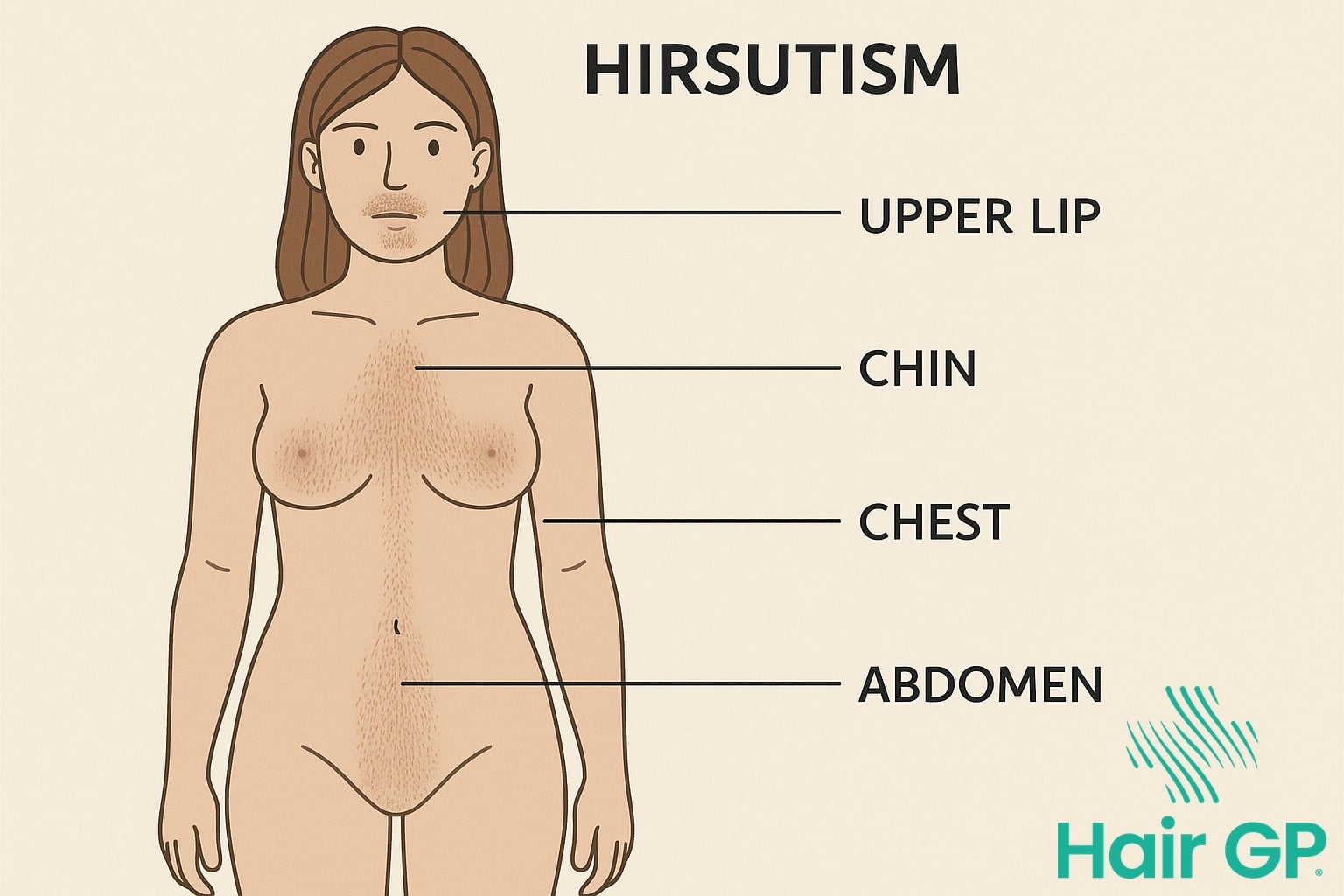
The Science Behind FDA-Approved Permanent Electrolysis
Electrolysis permanently destroys hair follicles through a scientifically-proven process that targets the hair’s growth cells with precision. As the only FDA-approved method for permanent hair removal, electrolysis employs electric current delivered through a sterile probe to eliminate the follicle’s regenerative capacity permanently.
Three Electrolysis Methods: Thermolysis, Galvanic, and Blend
The FDA recognises three distinct electrolysis modalities, each utilising different mechanisms to achieve permanent results. Thermolysis, the most commonly used method, produces heat through high-frequency alternating current that destroys the hair follicle’s growth centre within seconds [4]. This rapid thermal destruction coagulates the papilla and surrounding tissue, preventing future hair regeneration.
Galvanic electrolysis, the original modality developed in 1875, uses direct current to trigger a chemical reaction within the follicle. This process creates sodium hydroxide (lye), which progressively dissolves the growth cells through alkaline decomposition. Whilst slower than thermolysis, galvanic treatment ensures thorough follicular destruction, particularly effective for curved or distorted follicles.
The blend method combines both thermolysis and galvanic currents, leveraging the speed of heat destruction with the thoroughness of chemical decomposition [5]. This synergistic approach enhances treatment efficacy, particularly for resistant or deeply-rooted hairs common in hirsutism.
Why Only Electrolysis Offers True Permanency
Unlike laser treatments that target melanin, electrolysis permanently destroys all hair types regardless of colour or texture. The sterile probe delivers electric current directly to the dermal papilla and bulge region, eliminating stem cells responsible for hair regeneration [6]. This complete growth centre destruction ensures permanent removal, making electrolysis the sole FDA-approved permanent solution. Clinical studies demonstrate 90-95% permanent reduction after completing treatment courses, with destroyed follicles unable to regenerate new hair growth.
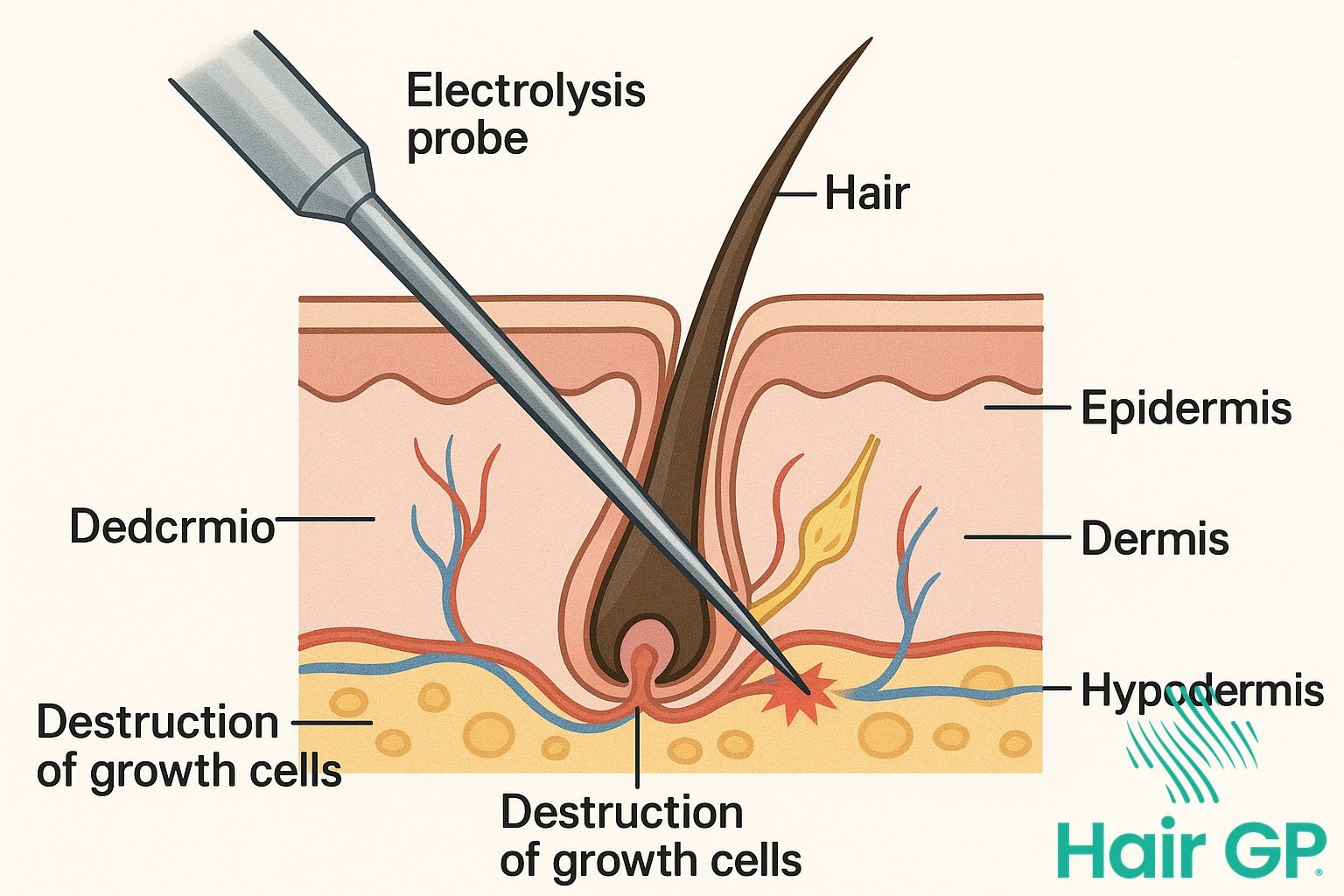
Electrolysis Treatments: What to Expect
Understanding what to expect from electrolysis treatments helps you prepare for your treatment programme and achieve optimal results. The journey from consultation to complete hair removal follows a structured timeline with specific care requirements at each stage.
Number of Sessions and Treatment Timeline
How many electrolysis treatments you’ll need depends on several factors, including hair density, treatment area size, and individual growth cycles. Most clients require 15-30 treatment sessions spread across 12-18 months for complete results. Initially, professionally performed electrolysis appointments occur weekly or fortnightly to target actively growing hairs. As hair density decreases, sessions space out to monthly intervals.
Multiple sessions are necessary because hair grows in cycles, and electrolysis only affects follicles in the active growth phase. Your treatment plan addresses approximately 20-30% of hairs per session. After completing the main treatment programme, occasional maintenance sessions every 3-6 months may address any regrowth from dormant follicles that later activate.
Pain Management and Comfort Options
Many clients wonder, “Is electrolysis painful?” Discomfort levels vary significantly depending on treatment location and individual pain tolerance. Sensitive areas like the upper lip typically cause more sensation than legs or arms. Applying numbing cream 30-45 minutes before treatment significantly reduces discomfort for most clients.
Additional comfort techniques include taking over-the-counter pain relievers beforehand and using ice packs immediately after treatment. Following proper post treatment instructions, including avoiding sun exposure and applying recommended soothing gels, minimises any lingering sensation and promotes faster healing between sessions.
Facial Hair Removal: Special Considerations
Treating unwanted facial hair requires special attention due to the delicate nature of facial skin and its prominent visibility. The upper lip, chin, and jaw line represent particularly sensitive areas where excess facial hair commonly develops, each presenting unique treatment considerations. These zones typically feature thinner skin than other body areas, making proper technique essential for minimising discomfort and ensuring optimal healing outcomes.
Facial hair removal through electrolysis demands modified approaches for different areas. The upper lip and lower lip regions require gentler current settings due to heightened nerve sensitivity, whilst the chin and jawline can typically tolerate standard treatment parameters. Post-treatment healing varies across facial zones, with the upper lip often experiencing slightly more swelling than other areas. Most clients find redness subsides within 2-4 hours, though sensitive areas may require overnight recovery before normal activities resume.
Applying makeup after electrolysis requires careful timing and technique to protect healing skin. Wait at least 24 hours before using cosmetics on treated areas, choosing mineral-based formulations that won’t clog pores or irritate sensitive skin. Incorporate gentle, fragrance-free facial skincare post-treatment, focusing on hydrating serums and broad-spectrum sunscreen to support healing whilst maintaining your regular beauty routine.
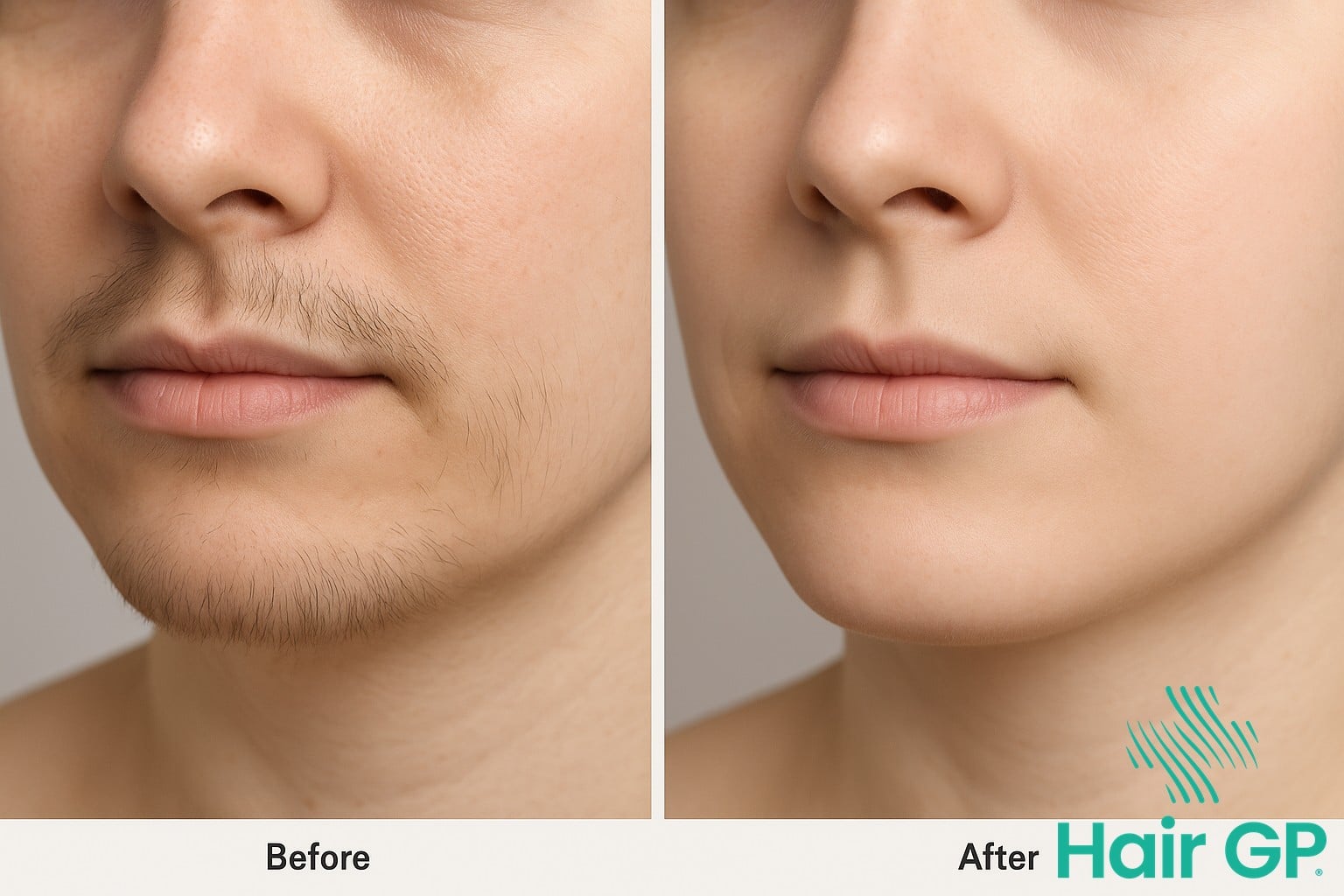
Electrolysis Hair Removal for All Skin Types
Unlike laser hair removal, which relies on melanin absorption and works best on dark hair against light skin, electrolysis hair removal achieves universal effectiveness across all skin types and hair colors [7]. This inclusivity stems from its fundamental mechanism—direct electrical current targeting the follicle itself rather than depending on pigment contrast. Whether treating fine vellus hair, red, blonde, grey, or white strands that laser cannot detect, electrolysis delivers consistent results through precise follicular destruction.
Particularly significant for individuals with darker skin tones, electrolysis eliminates the risk of hyperpigmentation or burning associated with laser treatments on melanin-rich skin [8]. The treatment safely addresses dark hair on darker skin—a challenging combination for laser systems—whilst equally effectively treating finer hair on any skin color. This versatility extends to all Fitzpatrick skin types, from the fairest to the deepest tones, making electrolysis the only permanent solution genuinely suitable for every individual regardless of their unique skin and hair types combination.
Managing Excess Hair from PCOS and Hormonal Conditions
Electrolysis provides effective permanent hair removal for excess hair caused by polycystic ovary syndrome (PCOS) and other glandular disturbances, even when hormone levels continue to fluctuate. Unlike temporary methods, electrolysis destroys the follicle’s growth centre, preventing regrowth regardless of ongoing hormonal changes affecting androgens and testosterone production[9].
When treating hormonal hair growth, electrolysis works alongside medical management of underlying hormonal causes. Coordinating treatment with endocrinologists ensures optimal outcomes, as controlling hormone imbalances through medication can prevent new terminal hair development whilst electrolysis eliminates existing unwanted hair. This dual approach addresses both current excess hair and reduces future growth stimulation from elevated androgen levels.
Realistic expectations prove essential when managing hormonally-driven hair growth. Whilst electrolysis permanently removes treated follicles, hormones may activate dormant follicles, requiring ongoing maintenance sessions[10]. Treatment frequency typically decreases over time as hormone management stabilises and fewer new hairs develop. Success depends on commitment to both electrolysis sessions and hormonal treatment compliance, with most clients achieving significant improvement within twelve to eighteen months of coordinated care.
How Does Electrolysis Treat Different Body Areas?
Electrolysis treats various parts of the body with customised approaches tailored to each region’s unique characteristics. Treatment strategies differ significantly between body areas, considering factors like hair density, skin sensitivity, and the total surface area requiring attention.
Large Area Treatment Strategies
When electrolysis treats larger areas such as legs, chest, or abdomen, practitioners typically divide these regions into manageable sections. The lower legs and thighs may require rotating between sections across multiple appointments, allowing proper healing whilst maintaining steady progress. Back and chest treatments often involve systematic grid patterns, ensuring complete coverage without overwhelming any single area. Time management becomes crucial, with sessions for these expansive zones typically scheduled for 60-90 minutes to maintain client comfort whilst achieving meaningful results.
Sensitive Area Considerations
Sensitive areas including the bikini line, underarms, and breasts require gentler approaches with modified settings. These delicate areas of the body often need additional numbing preparation and shorter treatment intervals. The bikini line and underarm regions typically heal more slowly than fingers and toes or other body hair locations. Practitioners adjust current levels and probe insertions carefully, allowing extra recovery time between sessions to prevent irritation whilst ensuring effective permanent hair removal.
How Does Electrolysis Compare to Other Hair Removal Methods?
Electrolysis stands alone amongst permanent hair removal procedures as the only FDA-approved method guaranteed to eliminate unwanted hair permanently [11]. When comparing electrolysis to other hair removal methods, its universal effectiveness regardless of hair colour or skin tone sets it apart from laser-based alternatives and temporary solutions.
Electrolysis vs. Laser: Key Differences
Whilst laser hair removal and laser assisted hair removal have gained popularity, fundamental limitations restrict their effectiveness. Unlike electrolysis, laser treatments rely on melanin absorption, making them ineffective for blonde, grey, red, or white hair [12]. Laser promoters often overlook these restrictions, but clinical evidence shows laser hair removal achieves permanent reduction rather than complete elimination. Additionally, darker skin tones face increased risk of hyperpigmentation with laser methods, whilst electrolysis safely treats all skin types through precise follicle targeting.
Temporary Methods: Why They Fall Short
Temporary hair removal methods like waxing, threading, and depilatories offer quick solutions but require endless repetition. Waxing damages skin through repeated pulling, often causing ingrown hairs and folliculitis. Threading irritates sensitive facial areas, whilst chemical depilatories can trigger allergic reactions. These other methods cost significantly more over time compared to electrolysis’s one-time investment. Unlike these temporary approaches, electrolysis addresses the root cause by destroying the hair follicle’s growth centre permanently. Considering long-term value, electrolysis compare favourably as the only hair removal option providing lasting freedom from unwanted hair.
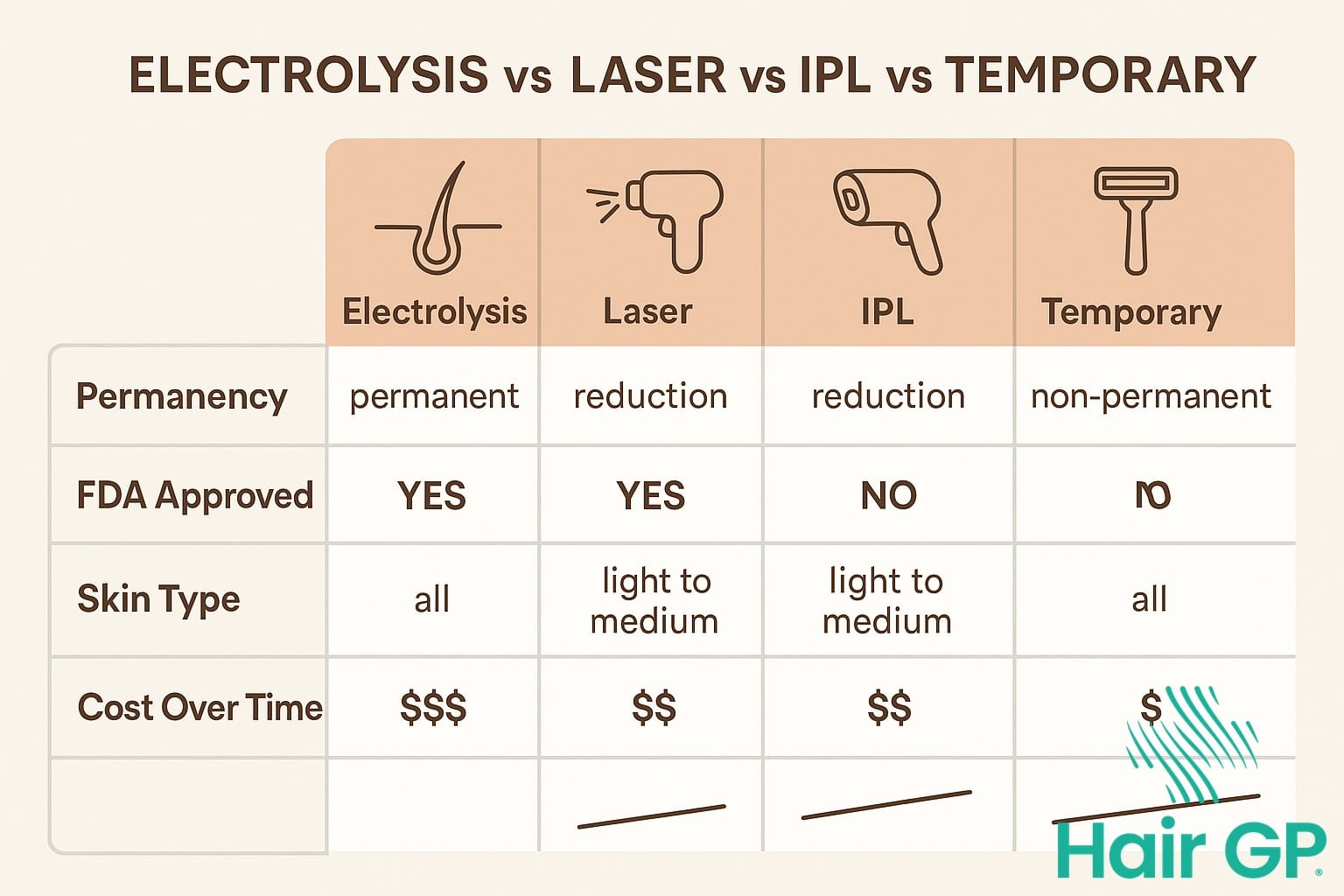
Conclusion
Electrolysis stands as the only FDA approved method for permanent hair removal, offering a proven permanent solution for individuals struggling with hirsutism. Unlike temporary treatments that require continuous maintenance, electrolysis delivers lasting results by permanently destroying hair follicles at their root, regardless of hair colour, skin tone, or underlying hormonal conditions. This universal effectiveness makes it the gold standard treatment for achieving truly hair free skin.
The journey to permanent freedom from unwanted facial and body hair begins with professional guidance. A certified electrologist possesses the expertise to assess your unique hair growth patterns, skin sensitivity, and treatment goals, developing a personalised programme tailored to your specific needs. Their specialised training ensures safe, effective treatments that maximise comfort whilst delivering optimal outcomes.
If you’re ready to invest in a permanent solution to hirsutism, scheduling a consultation with a certified practitioner represents the first step towards transformation. With consistent treatment and professional expertise, permanent hair removal through electrolysis can provide the life-changing results you’ve been seeking, restoring both confidence and quality of life.
Frequently Asked Questions
Most clients require 15-30 treatment sessions over 12-18 months, depending on hair density, treatment area size, and hormonal factors. Each hair follicle must be treated during its active growth phase.
Discomfort varies by individual and treatment area. Most describe it as a warm pinching sensation. Numbing cream can be applied 30 minutes before treatment for sensitive areas.
Yes, electrolysis is safe and effective for all skin tones and hair colors, unlike laser treatments which have limitations. It’s the only method with such universal acceptability.
No, professionally performed electrolysis permanently destroys the hair follicle’s growth cells. Once a follicle is successfully treated, it cannot produce new hair.
While initial investment is higher, electrolysis provides permanent results, making it more cost-effective long-term than lifetime waxing or multiple laser treatments.
References
- Mihailidis J, Dermesropian R, Taxel P, et al. Endocrine evaluation of hirsutism. Int J Womens Dermatol. 2017;3(1 Suppl):S6-S10.
- Teede HJ, Tay CT, Laven JSE, et al. Recommendations from the 2023 International Evidence-based Guideline for the Assessment and Management of Polycystic Ovary Syndrome. J Clin Endocrinol Metab. 2023;108(10):2447-2469.
- Matheson E, Bain J. Hirsutism in Women. Am Fam Physician. 2019;100(3):168-175.
- Richards RN, Meharg GE. Electrolysis: observations from 13 years and 140,000 hours of experience. J Am Acad Dermatol. 1995;33(4):662-666.
- Görgü M, Aslan G, Aköz T, Erdoğan B. Comparison of alexandrite laser and electrolysis for hair removal. Dermatol Surg. 2000;26(1):37-41.
- Michel CE. Trichiasis and distichiasis; with an improved method for radical treatment. St Louis Clinical Record. 1875;2:145-148.
- Ibrahimi OA, Avram MM, Hanke CW, et al. Laser hair removal. Dermatol Ther. 2011;24(1):94-107.
- Gan SD, Graber EM. Laser hair removal: a review. Dermatol Surg. 2013;39(6):823-838.
- Escobar-Morreale HF. Polycystic ovary syndrome: definition, aetiology, diagnosis and treatment. Nat Rev Endocrinol. 2018;14(5):270-284.
- Matheson E, Bain J. Hirsutism in Women. Am Fam Physician. 2019;100(3):168-175.
- Ibrahimi OA, Avram MM, Hanke CW, et al. Laser hair removal. Dermatol Ther. 2011;24(1):94-107.
- Gan SD, Graber EM. Laser hair removal: a review. Dermatol Surg. 2013;39(6):823-838.

